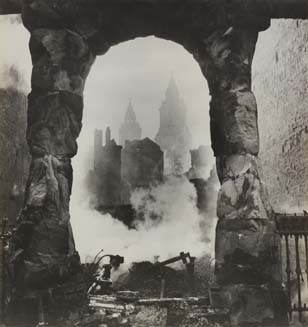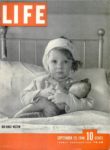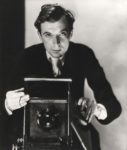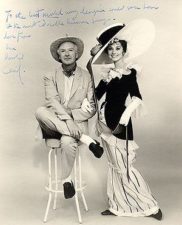

Cecil Beaton
British, 1904-1980 (active America and Great Britian)
St. Paul's seen through a Victorian Shopfront, 1940
gelatin silver print
16 3/4 x 15 3/4 in.
SBMA, Gift of Ala Story
1958.3315

Cecil Beaton in self portrait with large 8 x 10 camera.

Beaton and Audrey Hepburn in costume designed by Beaton for My Fair Lady, 1964.
COMMENTS
Throughout a distinguished career, Cecil Beaton achieved worldwide fame as a photographer, designer, writer, cartoonist, diarist and socialite.
The Hampstead-born photographer is widely remembered as the leading British portrait and fashion photographer of his day.
During his career he photographed Queen Elizabeth and the Queen Mother, who he described as his favorite royal sitter.
He was also employed as staff photographer for Vanity Fair and Vogue, and went on photograph Audrey Hepburn, Marilyn Monroe and Elizabeth Taylor.
As a commissioned war photographer, it was Beaton's image of a young girl in Great Ormond Street Hospital, which arguably persuaded America to join the global conflict.
Before the image was published on the cover of Life magazine in 1940, America was yet to participate in the Second World War.
But the evocative image saw the U.S. public put further pressure on their government to assist Britain.
After the Second World War he turned to Broadway, working as a set, lighting and costume designer.
His creative flair saw Beaton win Academy Awards for costume design on films Gigi (1958) and My Fair Lady (1964).
He also designed the period costumes for the 1970 film On a Clear Day You Can See Forever.
By the end of the 1970s his health had deteriorated, and he died at his Wiltshire home in January 1980, aged 76.
His eye-catching portfolio stays away from corpses, blood and the unimaginable horror of the front line, featuring instead photogenic soldiers presenting a united front for the Allied Forces.
Even so, Beaton does tug on the heartstrings in his collection: one of the most memorable images shows wounded three-year-old Eileen Dunne at Great Ormond Street Hospital, in an evocative picture which would later grace the cover of Life magazine in September 1940.
The picture was clearly effective - as it was taken with the aim of generating sympathy for the British and helping sway America into intervening in the war.
Elsewhere he features soldiers relaxing after a Libyan desert patrol and a sailor repairing a signal flag on the way to Sierra Leone.
Beaton took a staggering 7,000 pictures in all during the project, which were passed through the ministry's Censorship Division before being published in books and magazines.
But after being catalogued without using his name, the raft of images became lost in archives until they were recently re-discovered.
A collection of more than 100 pictures are now on display at London's Imperial War Museum, in an exhibition titled 'Cecil Beaton: Theatre of War'.
Hilary Roberts, head curator of the museum's photographic archive, found over 100 unknown pictures while examining files.
She recognized them as being similar in style to the work of Beaton, and confirmed they were his work by matching them to his diary records.
She said: 'The Ministry was in disarray in those days and the records weren't kept well.
'It was not practice to record the name of the photographer. But we always knew these images existed somewhere.'
After ceasing wartime operations, the Ministry of Information deposited Beaton's war photos with the Imperial War Museum, London.
The photographer was briefly reunited with his vast body of work shortly before his death.
Describing the experience, he wrote in his diary: 'Yesterday I went to the Imperial War Museum, not my favorite place, to see the collection of photographs that I had taken during the war for the Ministry of Information.
'It was an extraordinary experience to relive those war years; so much of it had been forgotten, and most of the people are now dead.
'It was fascinating to see the scenes in old Imperial Simla, the rickshaws drawn by uniformed servants, the grandeur of the houses, the palaces, the bar scenes, the men on leave swigging beer, I had not realized that I had taken so many documentary pictures, some of purely technical interest.
'Looking at them today, I spotted ideas that are now ‘accepted’, but which, thirty years ago, were before their time. The sheer amount of work I had done confounded me.'
More information about the Cecil Beaton exhibition can be found at the Imperial War Museum's website.
Read more: http://www.dailymail.co.uk/news/article-2199103/Cecil-Beaton-photos-Film-star-photographer-turned-lens-gritty-reality-Second-World-War-stunning-effect.html#ixzz4KqMLgr9Y
SBMA CURATORIAL LABELS
“Cecil Beaton's London’s Honorable Scars: Photographs of the Blitz” features the work of the well-known British fashion and celebrity photographer who became a photojournalist to help document the war.
Sir Cecil Beaton is best known for his iconic images of royalty and movie legends and multi-award winning designs for such films as “My Fair Lady,” Beaton created extraordinary photographs of Britain during World War II’s cataclysm. Already established in the 1930s as a major fashion, society and Hollywood photographer, Beaton was hired by the UK’s Ministry of Information at the war’s outset to persuasively reflect the hardships and spirit of the British nation during this legendary time of trial.
During an eight month period from the late summer of 1940, to the spring of 1941, Nazi Germany’s bombers attacked many of Britain’s cities, most notably London, in an effort to crush British morale, and force the nation’s surrender. The attacks killed 40,000 civilians, wounded more than 80,000, and destroyed a third of London, but the British held on, and the Germans eventually gave up the bombing campaign, and of course were defeated by the Allies in 1945.
This image belongs to Beaton’s London’s Honourable Scars, a portfolio that pictured the devastation and resilience of London during the Nazi Blitz of 1940–41. Capturing an era poetically summarized by Winston Churchill as Britain’s “finest hour” when Britain stood alone against the German onslaught, these riveting evocations of London’s destruction and persistence were given to the Santa Barbara Museum of Art by one of its former directors, Ala Story, in 1958. Among the earliest photographs to enter the Museum’s collection, they have seldom if ever been on view.
They are some very famous, and some not so well known photographs made by Beaton. Many of the photographs show some iconic London landmarks which have been damaged by the bombing, or are framed by debris.
Beaton was an unlikely candidate to be a photojournalist, but felt it was something he could do to help Britain’s war effort. Perhaps the most famous of the shots is a picture of St. Paul’s Cathedral, as it is seen in the distance through a bombed out business and square.
Charles Wylie curator of Photography at SBMA says he hopes people coming to the exhibition will not just experience history turned into art, but see a well known celebrity photographer in a new light.
Article from PR SBMA 2016
